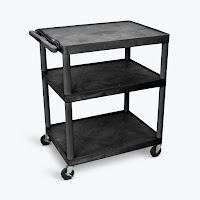Buying Guide: Radiant Heaters
Whether you need instant warmth indoors or outdoors, one of your best heating solutions is a radiant heater. This type of heater is one of the most common types of heaters today—it’s even used in a huge percentage of households across the country.
Also known as an infrared heater, a radiant heater uses a quartz heating element and is designed to emit healthy heat like that of the sun, without the harmful ultraviolet rays. Because of the type of heat distribution it uses, it warms nearby objects, surfaces, or people in an instant, rather than heating the air. That means you can feel the heat it generates way before it raises the ambient temperature.
Unlike fan-forced heaters and other types of heaters, radiant heaters do not circulate the air or allergens in a room, making them a perfect choice for those with allergies. Most radiant heaters are often used for small rooms and temporary heating, while other models (such as infrared curing heaters) are constructed for commercial and industrial applications.
If you’d like a heater that can give you quick healthy heat, then a radiant heater is no doubt a great investment. You can check out our reviews of the best radiant heaters today or read on and learn what factors you need to consider before buying one.
As a general rule of thumb, the room size that an electric radiant heater can heat can be identified by dividing the wattage by 10. This applies to rooms with 8-foot high ceilings.
For example, a 1,500-watt radiant heater can generate heat throughout a 150-square-foot room. Or if you need heat in a 500-square-foot office or warehouse, you should choose a 5,000-watt electric space heater.
Perhaps the most important accessory you might want to have with your heater is a built-in thermostat. Having a radiant heater with a thermostat can help you take the guesswork out of regulating heat. A thermostat lets you easily control the unit’s heat output and thus the room temperature. Some heaters even come with programmable thermostats or thermostats that automatically adjust the temperature according to your preferred settings.
Apart from a thermostat, a timer comes in handy in controlling your heater. It allows you to set how long you want the heater to run and what time it will automatically turn off. Not only does a timer help prevent any heater-related accidents but also helps you save energy.
Depending on how you’ll use your radiant heater, you might also want to purchase one with included mounting hardware, a handle, or wheels. That way, you won’t have any problem installing a ceiling- or wall-mount infrared heater or transporting it (if you choose a radiant space heater).
Also known as an infrared heater, a radiant heater uses a quartz heating element and is designed to emit healthy heat like that of the sun, without the harmful ultraviolet rays. Because of the type of heat distribution it uses, it warms nearby objects, surfaces, or people in an instant, rather than heating the air. That means you can feel the heat it generates way before it raises the ambient temperature.
Unlike fan-forced heaters and other types of heaters, radiant heaters do not circulate the air or allergens in a room, making them a perfect choice for those with allergies. Most radiant heaters are often used for small rooms and temporary heating, while other models (such as infrared curing heaters) are constructed for commercial and industrial applications.
If you’d like a heater that can give you quick healthy heat, then a radiant heater is no doubt a great investment. You can check out our reviews of the best radiant heaters today or read on and learn what factors you need to consider before buying one.
Heat Coverage
One of the first things you have to look for before you buy a radiant heater is its wattage, which indicates its heat output and heat coverage. If you need to warm a spacious garage or other huge rooms, you would probably want to get a heater offering 4,000 watts or higher. Or if you need a heater for a small space, a 1,500-watt infrared heater will be more than sufficient.As a general rule of thumb, the room size that an electric radiant heater can heat can be identified by dividing the wattage by 10. This applies to rooms with 8-foot high ceilings.
For example, a 1,500-watt radiant heater can generate heat throughout a 150-square-foot room. Or if you need heat in a 500-square-foot office or warehouse, you should choose a 5,000-watt electric space heater.
Accessories
Another factor you should consider when choosing a radiant heater is its included accessories.Perhaps the most important accessory you might want to have with your heater is a built-in thermostat. Having a radiant heater with a thermostat can help you take the guesswork out of regulating heat. A thermostat lets you easily control the unit’s heat output and thus the room temperature. Some heaters even come with programmable thermostats or thermostats that automatically adjust the temperature according to your preferred settings.
Apart from a thermostat, a timer comes in handy in controlling your heater. It allows you to set how long you want the heater to run and what time it will automatically turn off. Not only does a timer help prevent any heater-related accidents but also helps you save energy.
Depending on how you’ll use your radiant heater, you might also want to purchase one with included mounting hardware, a handle, or wheels. That way, you won’t have any problem installing a ceiling- or wall-mount infrared heater or transporting it (if you choose a radiant space heater).

Comments
Post a Comment